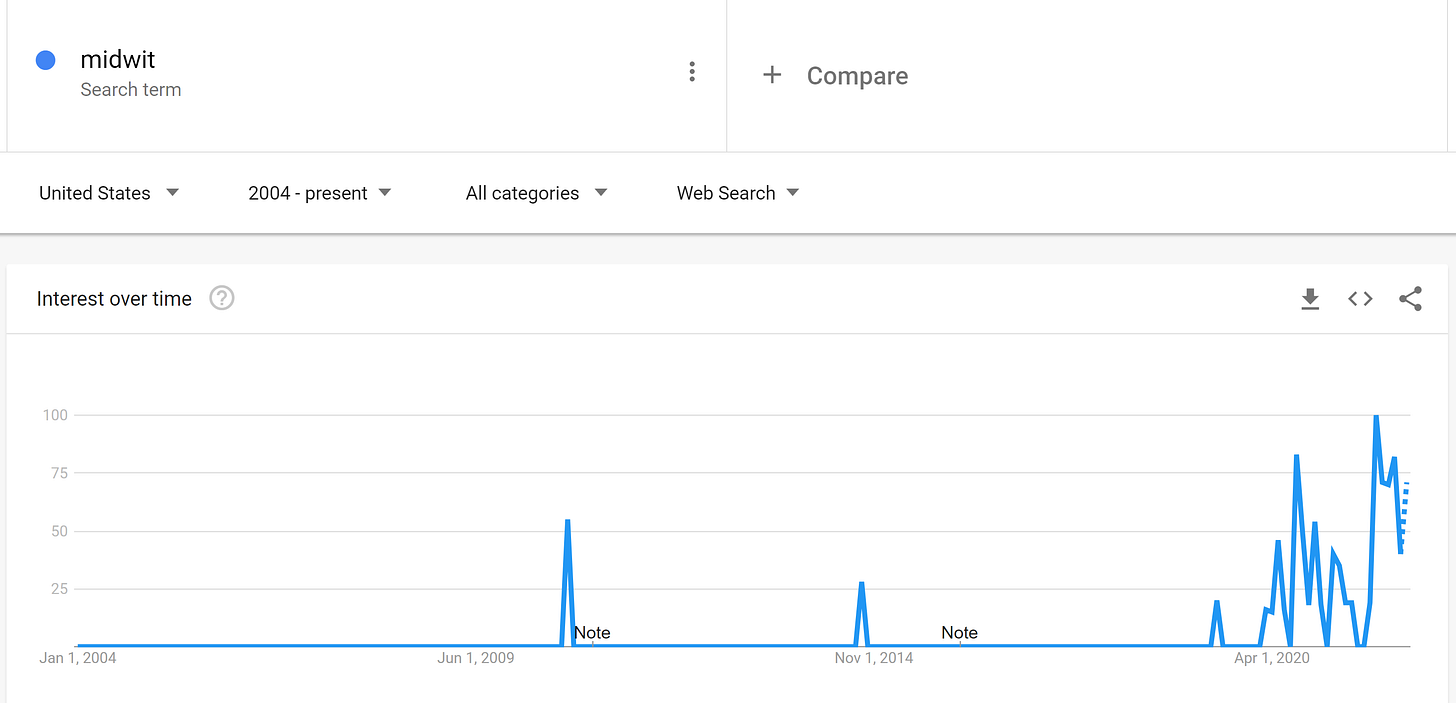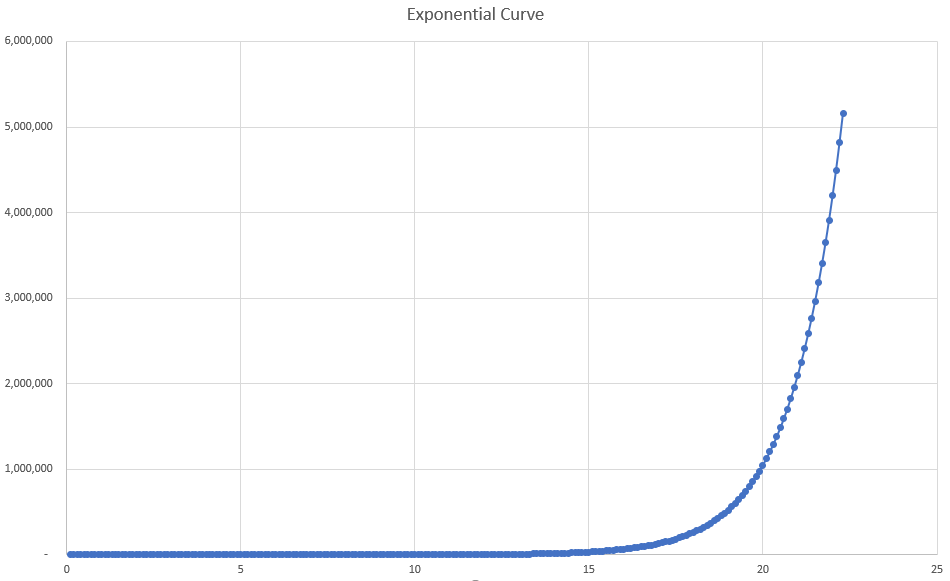Oh, The Mess the Midwits Have Made!
The Midwit Class, Second Order Thinking, and Exponentials Ad Absurdum
I’ve thrown around the term “midwit” a fair bit, and I daresay that I am a contributor to its rising popularity. I’ll use it 23 times in this piece, so buckle your seatbelts kids!
But even those with a bit more clout than yours truly are picking up on the concept. MIT Professor Arnold Kling has recently covered midwits well, which I recommend checking out below:
Kling, it should be known, is the originator of the wonderfully useful three-axis politics model, and probably I should have added into my recent piece on worthwhile sources in the decentralized media landscape.
As Kling quotes Chau in his piece, a midwit is “typically described as someone with an IQ score between 85 and 115; more colloquially, it describes a person with slightly above-average ability in any domain—someone who is able to pass basic qualifications and overcome standard hurdles but who is in no way exceptional.”
Hopefully, this brings things into focus. But what I want to cover today is one of the very telling logical fallacies which is helpful for both understanding and identifying midwits. We’ll also focus in on three areas dominated by these midwits: academia, journalism, and the managerial class. Midwits often have college degrees because these are no longer hard at all to obtain (in most fields) and are essential to rising up the career ladder in the high-prestige, low-critical-thinking fields they flock into. Together these make what we’ll call the midwit class, as they serve as the locus for midwit power and influence in the world today.
Much of the mess they’ve made, at least recently, comes from the idea that exponentials will continue forever. We can call this exponential ad absurdum.
And that is where we will begin our journey.
The Exponential Curve
Exponential curves are graphed by equations like y=2^x. Practically then, that means that something that starts small can grow quickly and “suddenly” become so huge that the new levels dwarf anything seen before.
So if you look at the early part of an exponential curve, it looks flat, or at least linear in nature. The bend upward is slight. But as you zoom out, or as time progresses, the function becomes anything but linear!
There are many classic examples of this: startup growth, viral replication or spread, or the network effects of a social network. Generally speaking, you’ll see exponential growth of anything where one person can influence more than one person. If each person gets 2 others sick, the growth is slow at first: 1 person is sick, then 2, then 4, then 8… but before you know it you are going from 16 million to 32 million and looking at 64 million next. The late-stage growth is the same as the early stage growth (one person infects two) but the scale of it dwarfs the impact of anything that came before it.
Orders of Thought
Exponentials in the real world are a great way to demonstrate first, second, and third order thinking, something described well in this Epiphany a Week post. But let’s demonstrate each order here. Assume the graph shown here is the number of subscribers to your software platform and you are speaking to three investors.
First Order thinkers would see the early part of an exponential and just say “hey, look, that’s flat. Or straight anyway, you aren’t going anywhere fast. I’m out.”
Second Order thinkers would correct them, and say “oh no - this process shows signs of going exponential. This could very quickly become a very big thing! I’m in!”
Finally, we have Third Order thinkers. Third order thinkers would rightfully realize “well, it does look exponential, but that of course cannot continue forever. Let’s consider your available market and natural constraints on sales to figure out when you will hit an asymptote.”
Put another way, third order thinkers realize that no exponential trend can continue forever, it’s an absurdity (hence, exponential ad absurdum). Mathematically, they realize that exponential curves are just the early part of a Sigmoid function in disguise:
Perhaps we can sum this up in one visual:
For those unfamiliar, these characterizations of each thinker come from the classic “midwit meme” of which you can find many (and this article would be woefully incomplete without one).
The Harms of the Midwit
So hopefully that gives you a bit better of an understanding of the midwit, who is regularly locked into second-order thinking. But this particular exponential fallacy is quite pervasive and pernicious. It captures the minds of many academics (exponential math is easier than sigmoid math), journalists (sensational headlines are good for business), and middle managers (sensational exponentials are great justification for an expansive management class). Together, these groups make up the central sphere of influence of the midwit class.
Let’s look at two cases in particular:
Covid
During the early stages of the pandemic, many of the VC crowd, including Balaji Srinivasan, were speaking often about how most people don’t have a good intuitive handle on exponential growth. And they were (at least partially) right in context: Covid cases were low but about to go up quickly.
But people glommed on to this. What could have been a nuanced point was taken over by the midwit machine: academics, journalists, and middle managers.
Academics, most prominently Neil Ferguson at the Imperial College in London, created scary “up and to the right” charts that presumed unchecked exponential growth of Covid cases that would far outstrip hospital capacity. These were used to justify the initial lockdowns and “15 days to slow the spread.” Despite being proven immensely wrong though in the initial wave, these folks have continued this trick with the Delta and Omicron waves, again warning of hospital overloads that still have yet to transpire.
Journalists then saw these charts and, lacking the necessary mathematic or critical thinking skills to properly assess, whipped up a mass hysteria. They ran headline after headline that grabbed attention (using fear) and, not coincidentally, helped increase their profitability. You have to give the media credit for at least one thing: they know what sells.
And then you have the managerial class. Both within the government and within companies (specifically HR, but elsewhere as well), Covid provided something to do with the added perk that they didn’t have to go into the office. “Job security AND I can work from bed in my pajamas? Sign me the heck up!” With the continual degradation of education, a modern middle manager typically lacks the critical thinking skills to move beyond second order thinking, especially if the media is providing confirmation.
Thus we can see how so much of the harmful policy that was put in place during Covid was driven by second order thinking of the midwit class. These policies ultimately did essentially nothing to stop the spread of Covid, yet brought great harms to millions of kids who are behind on their education, adults who lost their jobs, and the tens of thousands of teens and young adults driven toward deaths of despair by a policy of social isolation.
Climate
Despite all of the grievous harms done by the midwit class during Covid, they seem ready, willing, and able to do it again when it comes to the climate.
The same story plays out:
Second order thinkers (rightly) point out that human activity is causing unprecedented change in the climate.
But they drive themselves into a frenzy with exponential ad absurdem, drawing “hockey stick” charts that zoom up and to the right.
The journalists and media members run with the sensational headlines, knowing nothing sells better than “we’re all going to boil to death by 2030!”
The midwit managerials scurry around to create a bureaucracy to “manage” the situation.
Assuredly, their actions will have no measurable impact on the target metric (temperature) but they will have demonstrably and serious negative impacts on society in many other ways (increased poverty, loss of human rights, and more).
All the while, talk of any third order considerations is demonized and portrayed as garden variety first-order climate denialism.
So don’t you dare mention that Earth has several self-regulating mechanisms that would prevent a runaway greenhouse effect. Or that global cooling and the next ice age is actually a bigger threat. Or that earth would be better off as a warmer planet. Or that we have relatively available technology that could cool the planet if absolutely needed.
Conclusion
Midwits have come to dominate academia, journalism, and today’s managerial class. Taken together, these are a very strong locus on power that generates and spreads second order thinking. A prominent example of that, believing that exponential trends will continue on forever, is most clearly seen in the case of Covid and Climate Change.
This is harmful because second order thinking almost always ignores the secondary effects and unintended consequences. The myopic focus on one metric (covid cases, global temperature) leads to large harms in other areas while a bumbling bureaucracy does little to impact the primary metric anyway.
Once you see the pattern, you’ll start to notice it everywhere. Indeed, much (most? all?) of political discourse these days consists of stating some vague platitude and dismissing anyone who disagrees as a troglodyte. This, of course, allows you to artfully avoid any valid criticism or nuance coming from third order thinkers. Convenient!
troglodyte (n) - a person characterized by reclusive habits or outmoded or reactionary attitudes.As with many problems, the first steps are awareness and identification. Learn to see first, second, and third order thinking. Once you do, you’ll have no trouble spotting midwits, as they are usually eager to out themselves as such in conversation.
What you do next is up to you. For what it is worth, I suggest we view these people as the true troglodytes. There are relatively few flat earthers, but a Covid catastrophist is just as, if not more, of an incompetent thinker than the flat earther. Treat them as such!
As many seek social status above most everything else, perhaps knocking the midwit class down a peg or two in the social pecking order is the best way to mitigate the harms they’ve already brought to society.












Really good article.
I have noticed that outside of Silicon Valley, the engineering managers and tech leadership are all midwits. This is why the profitability of technology companies outside of SV is an order of magnitude lower than the ones in SV. The midwits are not just lacking ability, rather they think they are the topmost world tech leaders, and that their ideas are the best in the world. I worked at several locations, so I can tell their ideas are amateur. If the non-SV companies could avoid promoting midwits into engineering leadership, they could perform better. Midwits infiltrating leadership happens more in less competitive markets, and more traditional thinking populations. So it's not that everyone is dumb in the countryside, rather people in the countryside are more permissive of midwit deceptive behaviors, through misplaced respect.